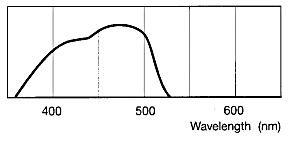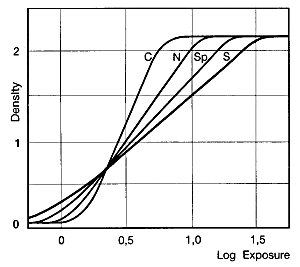FOMA
FOMABROM
BLACK-AND-WHITE ENLARGEMENT PAPER ON A BARYTA PAPER
BASE
General
FOMABROM is universal high sensitive black-and-white enlarging paper
on baryta coated double weight paper base. It is made of silver chlorobromide
emulsion with neutral to mildly warm image tone. The paper is noted for
its rich half-tone scale from shiny white to saturated black. Its high
speed makes possible to use larger lens diaph ragm values even at enlarging
on large sheet sizes. The paper shows the great developing latitude. It
is available in glossy, semi-matt, matt, fine grained lustre and silk surfaces
and contrast range from soft to hard (1 - 4) and in all current sizes.
Safelight
The paper can be handled for longer periode under red safelight or
under sodium vapour lamp. Safelight fitted with yellow-green or orange
filters is also suitable. However for standard darkroom illumination Kodak
OC, Osram Duka 50, Agfa G 7, Durst Sanat or Ilford 902 filters can
be used.
Exposure
FOMABROM is suitable for exposure in all types of enlar gers and printers
fitted with tungsten or tungsten-halogen lamps or common cold light sources.
Other light sources can be used, but tests to determine the optimum exposure
must be done.
Processing
FOMABROM can be processed in trays or in processors equipped for paper
bases. Various common developers can be used. For neutral image tone FOMATOL
LON, FOMATOL P, NEUTOL LIQUID NE, PQ UNIVERSAL, DEKTOL etc. are recommended.
Developers for multigra de papers can be also used.
Processing procedure
Process
sequence |
Process bath
|
Time
|
Temp.
(C) |
| Developer |
FOMATOL LQN 1+7 |
90 -120s |
20 |
| Stop bath |
2 % acetic acid |
20 - 30 s |
20 |
| Fixer |
FOMAFIX 1+7 |
3 min |
20 |
|
Acidic fixing bath |
5 min |
20 |
Wash
|
Running water
|
30 min
45 min |
above 12
bellow 12 |
Drying: The papers are suitable for hot drying. FOMA BROM glossy paper
can also be dried on drums and in glazing presses.
Image Tones
The silver chlorobromide emulsion of FOMABROM renders neutral to warm
black image, when developed in standard developers. Image tones can be
varied with use of appropriate developers.
Amidol in the developer gives deeper blue- black tones, metol alone
produces neutral black to bluish-black and hydroquinone used alone in restrained
developer tends to give warmer black images.
Chemical Toning
Toning processes convert the black image to a different
colour. There are two toning methods, direct and indirect.
Direct toning converts the silver image to a different silver
compound in one operation. The indirect one involves
bleaching first. A second solution creates a new image
consisting of a silver compound with a different colour.
FOMABROM is suitable for both direct and indirect
methods. For the standard process the indirect method
is recommended. The sepia tone is very popular. FOMA-
TONER SEPIA set is useful for this purpose. Tone changes
are reached by temperature controlling of the toning bath:
| temperature (C) |
Image tone |
| bellow 20 |
a lighter, yellow brown |
| 20 - 30 |
a deeper, mildly warm |
| above 30 |
a deep, cold brown |
Technical Data
| Grade |
ISO SPEED |
ISO RANGE |
D-max |
| 1 |
400 |
120 |
2,1 |
| 2 |
400 |
100 |
2,1 |
| 3 |
400 |
80 |
2,1 |
| 4 |
400 |
60 |
2,1 |
ISO RANGE: It is term
for the greatest exposure latitude at the defined maximum and minimum density,
in which details can be distinguished both in the shadows and in the highlights.
Hard grade papers are suitable for low cont rast negatives with shorter
density latitude. Soft grade papers have a greater ISO range, suitable
for copying from hard contrast negatives with great density latitude.
D-max : The values are valid for glossy
surface. The other surfaces show lower D-max.
Spectral Sensitivity

|
Density Curves
 |
Storage
FOMABROM is recommended to store in a cool, dry place in its original
packing at temperature bellow 20C and relative humidity between 50 and
60 %. No harmful gases and fumes should penetrate into the storage room.





